Manuscript accepted on : 10-06-2023
Published online on: 24-07-2023
Plagiarism Check: Yes
Reviewed by: Dr. Sonal Tuljaram Kame
Second Review by: Dr. Rajendra Jangde
Final Approval by: Dr. Ghulam Md Ashraf
Gayotree Agni Borah1 , Somim Nasreen2*
, Somim Nasreen2*  and Prasanna Kumar Dutta1
and Prasanna Kumar Dutta1
1Department of Zoology, Bahona College, Jorhat, India.
2Department of Life Sciences, Dibrugarh University, Dibrugarh, India.
Corresponding Author E-mail:somimbiology@gmail.com
DOI : http://dx.doi.org/10.13005/bbra/3152
ABSTRACT: The North East of India is rich in biodiversity. There are various species of fish found in the rivers, lakes and ponds of the region. Different ethnic groups from this region use different types of techniques to catch these fish. To study different aspects of fish, the study of fishing gears is prerequisite. People of Assam use different types of indigenous fishing gears to catch fish. Most of these fishing gears are made of bamboo. In the current study, attempts were made to analyse the ichthyofaunal biodiversity along with indigenous tools used to catch fish in the wetlands areas nearby Nimati Ghat in Jorhat. A study was conducted to record the traditional fishing techniques used in these places, and it had been discovered that there were ten various kinds of traps, nets, and hooks used for fishing. Many synthetic nets replace the traditional fishing gears. During the study, different kinds of fish were recorded from the study areas.
KEYWORDS: Diversity; Fish; Fishing gears; Jorhat; Wetland
Download this article as:| Copy the following to cite this article: Borah G. A, Nasreen S, Dutta P. K. A Study on Ichthyofaunal Diversity and Fishing Gears Used in the Wetlands Areas Nearby Nimati Ghat, Jorhat, Assam. Biosci Biotech Res Asia 2023;20(3). |
| Copy the following to cite this URL: Borah G. A, Nasreen S, Dutta P. K. A Study on Ichthyofaunal Diversity and Fishing Gears Used in the Wetlands Areas Nearby Nimati Ghat, Jorhat, Assam. Biosci Biotech Res Asia 2023;20(3). Available from: https://bit.ly/3DvIkFK |
Introduction
North East India is one of the hotspots of freshwater fish biodiversity in the world.1 The number of fishes reported from this area has varied greatly, ranging from 172 to 267.2,3 Assam is home to about 1.03 lakh hectares of lentic natural water bodies, including wetlands connected to the Brahmaputra, Barak, and their tributaries. Wetlands, which make up approximately 6% of the earth’s surface and are the most significant ecosystem, are a crucial component of both the terrestrial and aquatic ecosystems. Fish diversity is rich in the wetland ecosystems. 4-9 Studies have recorded the presence of 217 different fish species in different wetlands of Assam.10
The effectiveness of the materials used, the availability of fish, the choice of location, the timing, and other factors all affect how well a fishing approach works. Traditional, non-mechanized, and primarily locally made are the fishing equipment and crafts used in Assam. In Assam, methods such as grapping and the use of enormous, locally built nets are used to catch various types of fish due to the widely diversified natural water regions of the state.
The choice of equipment may vary according to the time of year, the body of water, the kind of fish targeted, and the efficiency of the equipment based on certain accepted standards. Numerous works have been carried out on the fishing gears, practices and cultural aspects of fisher folk by different authors across India; some authors have studied various aspects of fishing gears in different parts of Assam.11-17 Different workers have studied the community fishing and economic aspects of fishermen communities in Assam.18-21
A thorough survey was conducted to focus on the various types of fishing equipment used for fishing in Borsola beel with all of these factors in mind. Objectives of this current study were to catalogue the various fishing techniques employed by the Kaibarta population in Borsola beel and to investigate the frequency of occurrence of different fish species there.
Materials and Methods
The Borsola wetland (Open beel), which is about 5 kilometres to the northeast of Jorhat town in Assam, is situated in the geographic coordinates 26.048 ̊ N-26.049 ̊ N and 94.008 ̊ E-94.010 ̊ E. Fisherman collected the fish samples from the study area from 2021 to 2022. Moreover, fish were gathered from the fish landing spots. For further research, collected specimens were stored in a 5% formaldehyde solution. The fish species were identified in accordance with accepted literature. 22-23 Fishermen were asked about the features of the gears they used, their mode of operation and the kinds of fish they catch.
Results and Discussion
This study found the presence of 60 fish species from 20 families in different wetlands of Nimati , Jorhat, Assam. Several different types of gears to catch fish have been documented
during the research period. Different indigenous fishing gears, their charachteristics and type of fish they catch etc. are mentioned in Table 1.Scientific name, local name, family and their conservation status are mentioned in Table 2.
Berjal
It is a big rectangular seine net, and the term “tanaber” also refers to the surrounding net. The net is closed in a semicircle, using the coast as its foundation, and is slowly pulled in at each end to raise it onto the ground. After the boat detects the net, it travels towards coast. The catch is then gathered at the centre of the net once the net has been brought up. Berjal needs 10-15 persons and 7 to 4 boats to operate. The majority of the catch composition is made up of species such Wallago attu, Rita rita etc.
Gheko
It is a fishing device generally constructed in the outlet of the wetland to the nearby river. It is mainly made up of “banas”( bamboo). Before winter, fishes go out of the wetland through the feeding channel and they are caught while entering this device .
Phansijal
A typical gill net called a phansijal is smaller than a langijal. Additionally, it has a rectangular form and is composed of lightweight materials like nylon or hemp. This net is controlled by connecting it to a support (often bamboo) at one end of the river, and a rope is fastened to the other side.
Cast Net(Khewali jal)
Khewali jal, a cast net, is the most common type of gear in the study area. It is a conical cast net with an 8–15 mm mesh size, measuring 2–2.5 metres in length. The cone’s bottom circular border is doubled and ranges in height from 30 to 50 cm. The cone’s tip has a rope tied to it. The fisherman’s right hand held the folded net while his left held the rope’s end. Typically, all fish species are captured with this net.
Ghat Jal
It is made of triangular net fitted in a bamboo frame. The wide mouth side of the net is placed in the flowing water body opposite to water current. Fishes enter the net and they are caught in large number by dragging it up by weigh of the fisherman and kept alive in cage made by net.
Line and Hooks
Different types of lines and hooks are used to catch medium to big sized fishes which are as follows:
Sip boroshi
It is made of bamboo, which is frequently longer than 6 metres. A nylon line with a hook and a grasshopper or earthworm or small forage fish as bait is fastened to the tip of the bamboo. This type of hooks is used to catch small and indigenous fishes.
Nal boroshi
In this type a short line is attached with a floating piece of Nal(a hollow stem of riverine grass).In the other end a small live fish is attached to the hook and released to open lentic water bodies at night. Mostly Channa species are caught by this method.
Dham boroshi
Here many hooks with small pieces of lines are attached to a long rope and kept in suitable water bodies during night hours. Many fishes are hooked in this process.
Uvoti
It is constructed with thin bamboo sticks and placed with baits for trapping carnivorous Fishes. Mostly clarius species are caught in this process.
Polojal
Made up of triangular net fitted in a bamboo frame. Large sized fish of the species Labeo, Channa mauralius etc. are caught.
Table 1: Types of fish caught by the Gears and the production price.
|
Name of Gear |
Description |
Catches |
Individuals required |
Production price(Rs) |
Operational time |
Captured fish (kg) |
Earnings (Rupees per day) |
|
Berjal |
It is a big rectangular seine net. Now-a-days mosquito net is also used. |
All fishes are caught indiscriminately using plastic nets . |
7 -10 |
6000-10000 |
1-3 days |
Up to 400-500 |
500-1500 |
|
Phansi jal |
It is made up of delicate nylon fibre of different mesh sizes with floats and sinks. |
Different fishes up to 1-2 kg sizes are caught. |
1-2 |
500-5000 |
6-7 hours |
1-5 |
300-1000 |
|
Cast net (Khewali Jal )
|
Made with synthetic net consists of very small gaps in it. |
Catches all fishes according to type of net and mesh size. |
1 |
2000-5000 |
5-10 minutes each |
4-6 |
700-1000 |
|
Table 1: Continued |
|||||||
|
Polojal |
Made up of triangular net fitted in a bamboo frame |
Large sized fish of the species Labeo, Channa mauralius etc. are caught |
1 |
8-1000 |
15-30 minutes |
1-10 |
500-2000 |
|
Ghat jal |
Made up of large triangular net fitted in a bamboo frame |
Small and medium sized fishes are caught in large numbers. |
1 |
5000-1000 |
2-5 minutes |
1-100 |
500-10000 |
|
Sip Boroshi, Nal Boroshi, Dham Boroshi |
Made of Thin Bamboo Sticks with a thread bind in the anterior end of the stick and hooks at the end of the thread. |
Carnivorous fishes like Walagoo, Channa species are caught. |
1 |
50-100 |
30-60min |
.50-4 |
150-300 |
|
Uvoti |
It is constructed with thin bamboo sticks and placed with baits for trapping carnivorous medium sized fishes e.g. Clarias, |
Carnivorous medium sized fishes e.g. Clarias |
1 |
20-50 |
30min |
10-15kg |
150-300 |
Table 2: Diversity of Fishes in Borsola Beel
|
Sl no. |
Scientific Name |
Common Name |
Family |
Frequency |
Conservation status |
|
1 |
Chitala chitala(Ham) |
Chital |
Notopteridae |
Common |
EX-NA |
|
2 |
Notopterus notopterus (Pallas) |
Kandhuli |
Notopteridae |
Very common |
LC |
|
3 |
Gudusia chapra(Ham) |
Koroti |
Clupeidae |
Common during Summer |
EX-NA |
|
4 |
Hilsa ilisha(Ham) |
Ilish |
Clupeidae |
Common |
EX-NA |
|
5 |
Amblypharyngodon mola(Ham) |
Mowa |
Cyprinidae |
Very common |
LC |
|
6 |
Pseudeutropius atherinoides |
Bordua |
Cyprinidae |
Common |
LC |
|
7 |
Aspidoparia morar (Ham) |
Boriala |
Cyprinidae |
Occasional |
EX-NA/DD |
|
8 |
Catla catla(Ham) |
Bahu |
Cyprinidae |
Common |
LC |
|
9 |
Chela atper(Ham) |
Selkona |
Cyprinidae |
Common |
EX-NA |
|
10 |
Cirrhinus mrigala(Ham) |
Mirika |
Cyprinidae |
Very common |
LC |
|
11 |
Cirrhinus reba (Ham) |
Bhangun |
Cyprinidae |
Common |
LC |
|
12 |
Esomus denricus(Ham) |
Dorikona |
Cyprinidae |
Very common |
EX-NA |
|
13 |
Labeo rohita(Ham) |
Rahu |
Cyprinidae |
Very common |
EX-NA |
|
14 |
Labeo beta (Ham) |
Bhangon |
Cyprinidae |
Common |
EX-NA |
|
15 |
Labeo boga(Ham) |
Bogabata |
Cyprinidae |
Common |
EX-NA |
|
16 |
Labeo calbasu(Ham) |
Mali |
Cyprinidae |
Common |
EX-NA |
|
17 |
Labeo gonius(Ham) |
Kunhi |
Cyprinidae |
Very common |
EX-NA |
|
18 |
Punctius chola(Ham) |
Cheni puthi |
Cyprinidae |
Common |
EX-NA |
|
19 |
Punctius phutunio(Ham) |
Chokori puthi |
Cyprinidae |
Very common |
EX-NA |
|
20 |
Punctius sarana(Ham) |
Kani puthi |
Cyprinidae |
Common |
EX-NA |
|
21 |
Punctius sophore(Ham) |
Puthi |
Cyprinidae |
Very common |
EX-NA |
|
22 |
Punctius ticto(Ham) |
Henduri puthi |
Cyprinidae |
Common |
EX-NA |
|
23 |
Rasbora daniconius(Ham) |
Dorikona |
Cyprinidae |
Common |
EX-NA |
|
24 |
Ctenopharyngodon idella(Valenciennes) |
Common carp |
Cyprinidae |
Common |
LC |
|
25 |
Cyprinus carpio communis(Linn) |
Silver carp |
Cyprinidae |
Common |
VU |
|
26 |
Botia dario(Ham) |
Gethu |
Cobitidae |
Common |
LC |
|
27 |
Aorichthys aor(Ham) |
Ari |
Bagridae |
Common |
LC |
|
28 |
Mystus bleekeri(Ham) |
Singara |
Bagridae |
Common |
LC |
|
29 |
Mystus cavasius(Ham) |
Lalua singara |
Bagridae |
Very common |
LC |
|
30 |
Mystus tengra(Ham) |
Singara |
Bagridae |
Common |
LC |
|
31 |
Mystus vittatus(Bloch) |
Singara |
Bagridae |
Common |
LC |
|
32 |
Rita rita(Ham) |
Ritha |
Bagridae |
Common |
LC |
|
33 |
Ompok bimaculatus (Bloch) |
Bami |
Siluridae |
Common |
NT |
|
34 |
Ompok pabda(Ham) |
Pavo |
Siluridae |
Common |
NT |
|
35 |
Ompok pabo (Ham) |
Pavo |
Siluridae |
Common |
NT |
|
36 |
Wallago attu(Schneider) |
Borali |
Siluridae |
Common |
VU |
|
37 |
Alia colia(Ham) |
Kokila |
Schilbeidae |
Common |
EX-NA/DD |
|
38 |
Dario dario (Ham) |
Gatho |
Badidae |
Common |
DD |
|
39 |
Monopterus cuchia(Ham) |
Cuchia |
Symbranchidae |
Common |
LC |
|
40 |
Heteropneustes fossilis(Bloch)) |
Singi |
Heteropneustidae |
Common |
EX-NA/DD |
|
41 |
Chaca chaca(Ham) |
Kurkuri |
Chacidae |
Common |
LC |
|
42 |
Xenentodon cancila(Ham) |
Kokila |
Belonidae |
Common |
LC |
|
43 |
Chanda nama(Ham) |
Chanda |
Chandidae |
Common |
LC |
|
44 |
Parambasis ranga (Ham) |
Chanda |
Chandidae |
Very Common |
EX-NA/DD |
|
45 |
Parambasis baculis(Ham) |
Chanda |
Chandidae |
Common |
EX-NA/DD |
|
46 |
Nandus nandus(Ham) |
Gadgedi |
Nandidae |
Common |
LC |
|
47 |
Glossogobius giuris(Ham) |
Patitmutura |
Gobidae |
Common |
DD |
|
48 |
Anabus testudinius(Ham) |
Kawoi |
Anabantidae |
Very common |
VU |
|
49 |
Colisa fasciata (Schneider) |
Kholihona |
Belontidae |
Very common |
EX-NA/DD |
|
50 |
Colisa lalia(Ham) |
Kholihona |
Belontidae |
Common |
EX-NA/DD |
|
51 |
Channa barca (Ham) |
Futuki senga |
Channidae |
Common |
DD |
|
52 |
Colisa gachua(Ham-Bloch) |
Sengali |
Channidae |
Very common |
LC |
|
53 |
Colisa marulius(Ham) |
Saal |
Channidae |
Common |
LC |
|
54 |
Colisa punctatus |
Goroi |
Channidae |
Common |
LC |
|
55 |
Colia stewarti(playfair) |
Sol |
Channidae |
Common |
LC |
|
56 |
Colisa straitus(Bloch) |
Sal |
Channidae |
Common |
LC |
|
57 |
Macrognathus aculeatus(Bloch) |
Tora |
Mastacembelidae |
Common |
LC |
|
58 |
Macrognathus puncalus(Ham) |
Jati tora |
Mastacembelidae |
Common |
EX-NA/DD |
|
59 |
Macrognathus astacambelus aral |
Tora |
Mastacembelidae |
Common |
EX-NA/DD |
|
60 |
Tetrodon cutcutia(Ham) |
Gangatup |
Tetrodontidae |
Common |
EX-NA/DD |
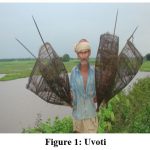 |
Figure 1: Uvoti
|
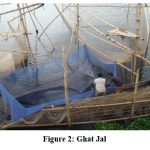 |
Figure 2: Ghat Jal
|
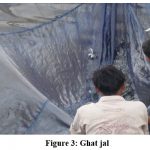 |
Figure 3: Ghat jal
|
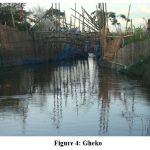 |
Figure 4: Gheko
|
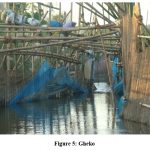 |
Figure 5: Gheko
|
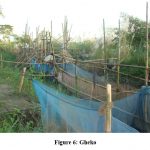 |
Figure 6: Gheko
|
Conclusion
In the present study, it has been found that the quantity of fishes caught in every gear has been decreasing resulting over exploitation of wetlands. Indiscriminate catching of fishes violating fishing laws results in lesser production in the successive years. For conservation of indigenous fish species and the traditional gears indiscriminate fish catching during breeding season must be banned.
According to the current study, fish are caught in the study region using different types of fishing equipment. The majority of people living in the study region depend primarily on agriculture and fishing for their livelihood, and traditional fishing gear plays a significant role in preserving their way of life.
Acknowledgement
Authors would like to thanks the fishermen of Borsola Beel ,Jorhat for sharing their knowledge about the fishing gears and helping us in collecting different fish species.
Conflict of Interest
There is no conflict of interest.
Funding Source
There is no funding sources.
Reference
- Kottelat M and Whitten Freshwater biodiversity in Asia with special reference to fish. World Bank Technical Paper. , 1996 ;343. 1-59.
CrossRef - Ghosh K. and Lipton A.P. Ichthyofauna of the N.E.H. Region with special reference to their economic importance. ICAR Spl. Bulletin No. 1 (ICAR Research Complex, Shillong) .,1982; 119-126
- Sen N . 2000. Occurrence, distribution and status of diversified fish fauna of North East India. In: Fish Germplasm Inventory and Conservation in North East India (Eds. A.G. Ponniah and U.K. Sarkar), NBFGR, Lucknow.
- Agarwala N. K. Limnology and fish productivity of Tamranga wetland in Bongaigaon district of Assam (India) with special reference to some productivity indicators. Ph.D. Gauhati University, Guwahati, (1996).
- Deka T. K , Kakati M. and Goswami M. M. Diversity of wetland fish and its impact on the income of fishermen community of Assam. Indian Fish. Assoc., 2001., 26:11-22.
- Dey S. C. Studies on the hydrobiological conditions of some commercial lakes (Beels) of Kamrup District of Assam, their bearing on fish production. Final Technical Report, North Eastern Council., 1981.,177 .
- Kumar P. and Meenakumari Suggestion for management of beels, the Brahmaputra river system,Assam. Aquacult.2002.,3(2): 223-228.
- Goswami T. K. and Goswami M. Icthyofaunal diversity and catch statistics of Jamlai wetland in Kamrup district of Assam, India. J. Inland Fish. Soc. India., 2006.,38(2): 38-44.
- Nayak and Mishra A. K. Socio economic condition of fishermen and its effects on environment. A case study of Ganjam district,Orissa. J. Nat. Environ. Poll. Technol., 2008.,7(1):111-116.
- Bhattacharjya B. K, Choudhury M. and Sugunan V. V. Ichthyofaunastic resources of Assam with a note on their sustainable In: Participatory Approach for fish biodiversity conservation in North East India. Pub. Director, NBFGR,Lucknow, India., 2003.,87-105.
- Kurien The Socio Cultural aspects of Fisheries: Implication for food and livelihood security- A Case Study of Kerala State, India, in J.R.
- McGoodwin (ed) Understanding the cultures of fishing communities: A key to fisheries management and food security, FAO Fish. Tech. Pap. No.401, 2001.
- Census of the Artisanal Marine Fishing Fleet of Kerala State. (South Indian Federation of Fishermen Societies, Thiruvananthapuram, India, 1992)
- Kar D and Dey S.C. Gill Nets in Lake Sone of Assam with their Economics and Impact on Fishery,Journal of Applied Zoology Research.2(2), 1991., 76-79.
- Kar D and Dey S.C. Variegated encircling gears in Lake Sone of Assam, Journal of Applied Zoology Research., 4(2):171-175.
- Kar D and Dey S.C, Scooping Gears of Lake Sone in Assam, Journal of Applied Zoology Research,, 7(1): 65-68
- Gurumanyu S.D. and Choudhury M.Fishing Methods in the Rivers of NortheastIndia, Indian Journal of Traditional Knowledge, 2009.,8 (2): 237-241
- Dey S.C. Community fishing in Assam and its impact on beel fisheries, Assam Science Society Conference 31, Guwahati 1984, 14-15
- Deka J, Bhuyan S.K , Baruah C and Rahman M. Sustainable Economy and Livelihood through Participatory Approach in the Deeporbeel Wetland of Assam. National Seminar on Wetland and Livelihood, Guwahati.2008.,245-248.
- Deka T.K. Status of Wetland and their Impact on the Livelihood of fisherman Community of Assam. Proc. National Seminar on Wetland and Livelihood, Guwahati. 2008., 249-263
- Barman R and Boro A. Wetlands in Assam: an Appraisal of their Natural and Socio-economic Importance. National Seminar on Wetland and Livelihood.Guwahati, 2008., 227-237.
- Talwar K. and Jhingran A.G. Inland Fishes of India and Adjacent Countries. Oxford-IBH Publishing Co. Pvt. Ltd., New Delhi.1991.,1158
- Jayaram C.The fresh water fishes of the Indian Region. Narendra Publishing House. Delhi. 1999., 551
Abbreviations
LC: Least Concern, EX-NA : Not applicable, DD : Data deficient, VU: Vulnerable, EX : Extinct.
(Visited 247 times, 1 visits today)
This work is licensed under a Creative Commons Attribution 4.0 International License.





